Aberdare Urban District Council Tramways
History
Aberdare Urban District Council Tramways (AUDCT) was unique in the British Isles in being planned and built as a combined tram and trackless trolley (trolleybus) system; the latter were expected to act as feeder services for the trams, and were no doubt conceived as a means of serving the maximum number of people without incurring an excessive outlay. The tramway system was built to a gauge of 3ft 6ins and was initially only 2.75 miles long, running broadly northwest to southeast from Trecynon, though Aberdare to Aberaman. Services commenced on the 9th October 1913, a relatively late opening date for an electric tramway, with the first trolleybus feeders starting around three months later in January 1914.
Problems were experienced with trolleybus operation from the start, the council having selected the unusual Cedes-Stoll system. This had a rather bizarre arrangement whereby a trolley ran along two overhead power lines, the electrical feed passing down a flexible cable to the vehicle itself, which had the motors built into the rear wheels. Unfortunately, the motors were continually jolted by the appalling road surfaces of the area, and this, coupled with dirt ingress and inadequate cooling, led to significant problems with the armatures, which needed frequent and expensive rewinding by specialists. Matters inevitably took a turn for the worse with the outbreak of the Great War, spares for the Austrian-manufactured current collection system being impossible to obtain, resulting in ever fewer vehicles being available for service as the conflict wore on.
In 1919, the council finally threw in the towel, ordering its first motorbuses, the first of which commenced operation on the 12th November 1920; the buses were intended both as feeders for the tramway and as replacements for the troublesome trackless trolleys. The tramway however, remained at the core of the council's thinking, and in September 1920, work began on converting two of the trackless trolley routes to tramcar operation, extending the tramway system from Aberaman — southwestwards to Cwmaman and southeastwards to Abercwmboi — taking the system to its final total of 5.77 miles. The replacement of trolleybuses by trams was a unique occurrence in the British Isles, with many tramway operators pursuing precisely the opposite policy in the 1930s, though of course with more modern vehicles than Aberdare had to deal with. Although Aberdare UDC was one of the early pioneers of trolleybus operation, by the early 1920's it had certainly had its fill. Unfortunately, major expenditure on the tramway coincided with the severe industrial downturn of the 1920s, which disproportionately impacted towns like Aberdare, with its heavy reliance on a single industry, namely, coal mining. During the decade, not only did the population decline by 11%, but those who stayed often struggled for work; this inevitably meant fewer passengers for the tramway, at the very time that it needed to pay off the huge debt that had been incurred. As a consequence, the tramway struggled financially, and was destined to return a loss every year for the remainder of its existence. Having spent so much money, the council simple hung on, which was to handicap it in later years as it failed to expand bus services outside the town, a void that was quickly filled by private companies and entrepreneurs.
On the 14th May 1934, faced with a badly deteriorating system, the council finally decided to abandon the tramway and replace the services with motorbuses. The last tram ran on the 1st April 1935.
Uniform
Despite the fact that Aberdare UDC Tramways opened as late as 1913, photographs that show staff in anything other than greatcoats — at least taken prior to the 1930s — are very thin on the ground. However, as the uniforms used by Aberdare trolleybus and bus staff were almost certainly the same, and photographs of them have survived, it seems highly likely that tramway crews wore single-breasted jackets with six nickel buttons (bearing a monogram and title — see link), two breast pockets (with button closures) and stand-up collars; the latter probably bore an employee on the bearer's left-hand side (in individual nickel numerals) and system initials (possibly 'A U D C T' or 'A C T') on the right-hand side (in individual nickel letters). The tensioned-crown peaked caps bore standard, 'off-the-shelf', script-lettering grade badges — either Motorman or Conductor — presumably in nickel to match the buttons. In the last few years of the system's life, a switch was made to single-breasted jackets with four buttons, two waist pockets and lapels; the upper part of the latter (i.e., the collars), carrying embroidered system initials — again probably either 'AUDCT' or 'ACT' — on both sides.
The council's 'Electricity and Tramways Committee', which dealt with tramway and bus matters, was renamed the 'Electricity and Transport Committee' in 1930. It is possible that new uniform issues after this date (to both tramwaymen and busmen) would have borne 'Aberdare Transport' buttons.
The vast majority of surviving photographs show tramway staff in long, double-breasted greatcoats with five pairs of buttons, high fold-over collars and epaulettes (with button closures); the latter probably bore an employee number on both sides, though this cannot be confirmed photographically.
Photographs of inspectors taken prior to the 1930s have not survived, so it is currently impossible to say what uniforms were worn during the first 15 to 20 years of operation. By the 1930s however, they were certainly wearing jackets of a very similar style to those issued to tramcar staff, namely: single-breasted with two waist pockets, four buttons and lapels; it is likely that the latter bore the same system initials as seen on tramcar staff jackets. Caps were also in the same style as issued to tramcar staff, but with the grade — Inspector — in embroidered script lettering, carried on a hatband, and with braiding on the peak. Inspectors were also issued with double-breasted overcoats with four pairs of buttons (possibly plain black composite), three waist-level pockets and high, fold-over collars; the latter bore the grade — Inspector — in embroidered script lettering.
Aberdare — like most UK tramways — employed female staff as conductresses during the Great War to replace men lost to the armed services. Photographs are however yet to come to light, so it is currently unclear what uniforms, if any, these ladies wore.
Further reading
For a history of the AUDCT, see: 'The Tramways of Aberdare' by 'R J S Wiseman, in the Tramway Review' Nos 129 (p3-13), 130 (p35-51), 131 (p67-83), 132 (p99-109) and 133 (p131-142); Light Rail Transit Association (1987-1988).
Images
Motormen and conductors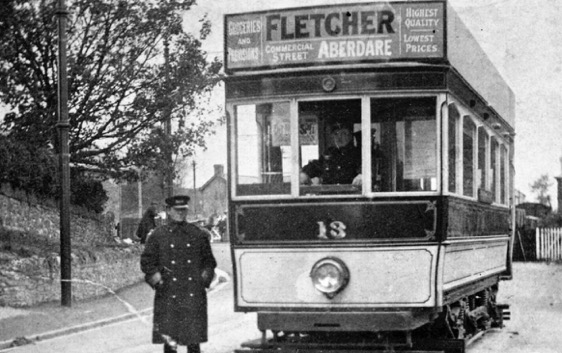
The crew of Tramcar No 13 pose for the cameraman — photo undated, but given the immaculate condition of the vehicle, probably taken in the last couple of months of 1913. Both men appear to be wearing double-breasted greatcoats without insignia, along with tensioned-crown peaked caps bearing script-lettering grade badges. Photo courtesy of the Tramways and Light Railway Society.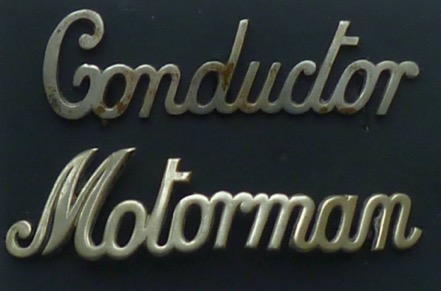
Standard 'off-the-shelf' script-lettering cap badges of the type worn by Aberdare UDC Tramways staff — nickel. Author's Collection.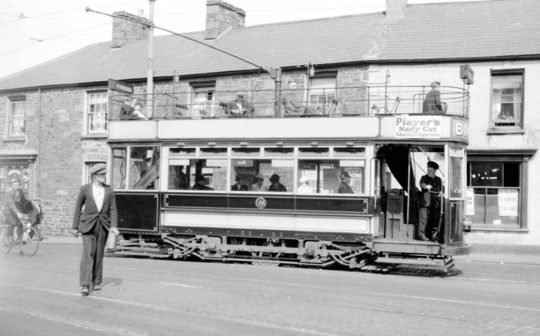
An unidentified open-top tramcar (probably in the No 21 to 26 series) captured for posterity on the 29th August 1930. Photo by Dr H Nicol, courtesy of the National Tramway Museum. 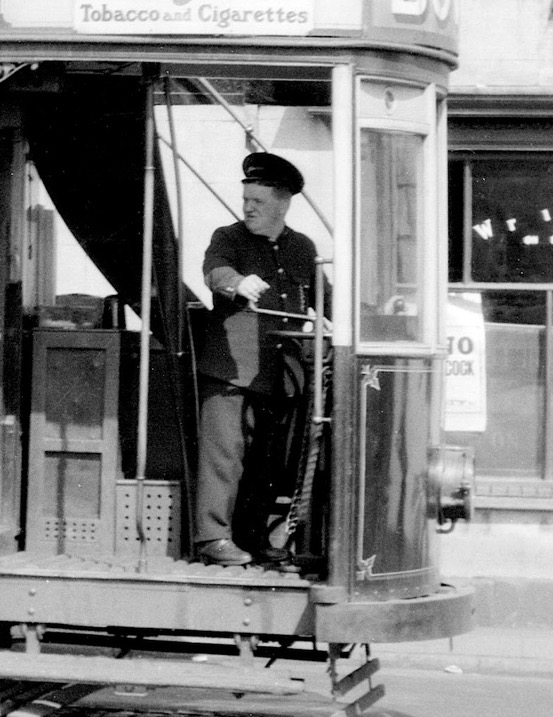
An enlargement of the above photo showing the motorman, who is wearing a single-breasted jacket with stand-up collars. 
A staff photo taken on 31st March 1935, presumably to mark the last day of tramway operation. Note the excellent condition of the tram. Author's Collection.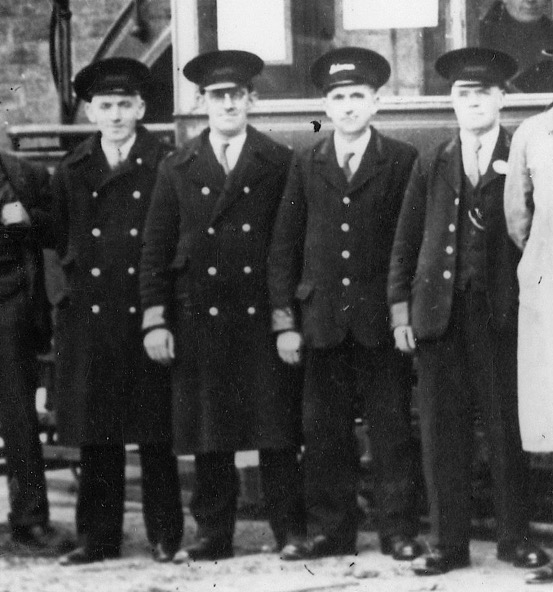
An enlargement of the above photo showing four of the tramcar staff, all of whom are wearing metal script-lettering grade badges, either Motorman or Conductor. The collar badges appear to be embroidered, and are possibly the system initials, 'AUDCT'.
Senior staff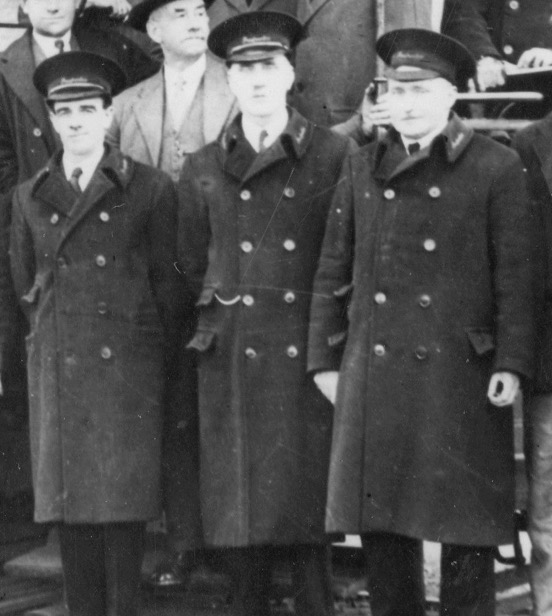
A group of three inspectors in their overcoats, taken from the last day photograph above. The braided caps carry Inspector in embroidered script, as do their overcoat collars.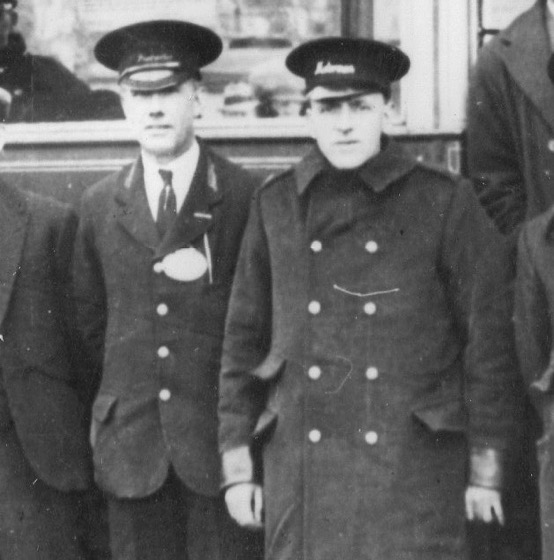
A photograph of an inspector in single-breasted jacket, with braided cap and somewhat unusually, wearing what appears to be a licence.